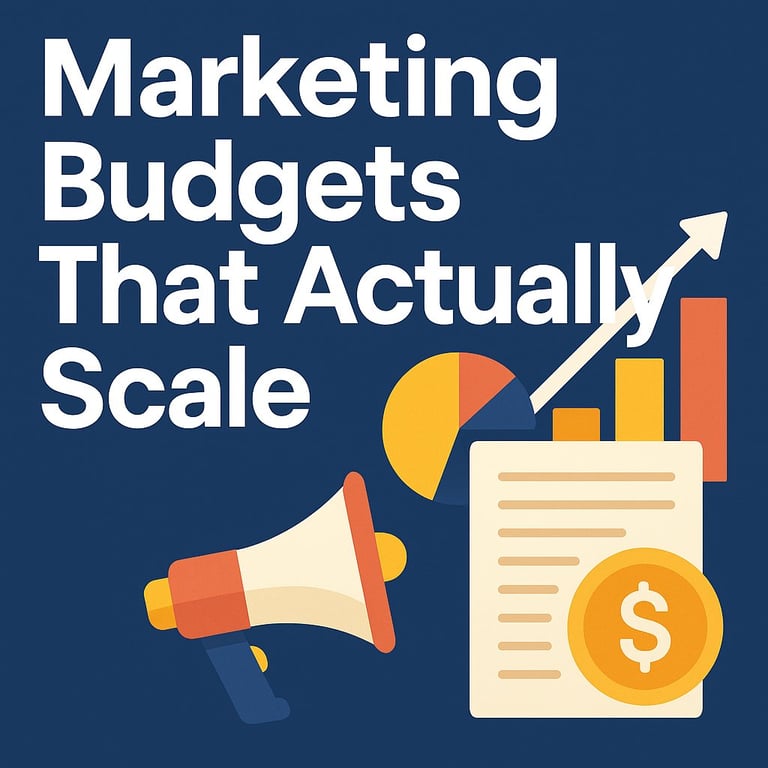
I. Current Digital Marketing Budgets in 2025
Most companies set their marketing spend between six and ten percent of gross revenue. That range shifts based on goals, business maturity, and margin.
A digital marketing agency business plan built to scale might allocate twelve percent or more in its first year.
A seo agency that earns from long-term retainers might set its spend at seven percent while focusing on content and client education.
Product-based companies running ecommerce automation models often cycle twelve to fifteen percent to support paid acquisition and funnel testing.
It’s not about the number. It’s about what that number is doing.
Examples:
A service business making $500,000 might invest $35,000 into a mix of Facebook Ads, blog content, and email tools.
A boutique seo agency earning $850,000 might use $60,000 across local rankings, automation software, and CRM upgrades.
A digital marketing agency 2025 benchmark for scale would use $150,000 to $200,000 to fuel lead magnets, retargeting, and content campaigns.
II. Real Factors That Shape Your Marketing Budget
Spend is shaped by leverage points. These are the factors you need to understand before allocating a single dollar.
Business phase
A new agency pushing for presence needs content velocity and outbound spend. A brand with years of equity and client traffic might prioritize conversion optimization and upsells.
Product margins
Thin margins force accuracy. If your cost per acquisition creeps too high, you bleed. Higher margin services—like ai seo agency packages or specialized seo agency service delivery retainers—create room to run ads aggressively.
Sales process
One-call closes are easier to scale with volume. Offers with longer cycles need layered funnels and consistent engagement. If you sell consulting or retainers, your CRM becomes as valuable as your ads.
Buyer awareness
Launching a new solution in a cold market takes education. If you’re competing in a warm category like seo digital marketing agency services or ecommerce automation, your budget shifts toward differentiation and creative rotation.
Back-end systems
Before you spend, check your funnel. A bad email flow or broken calendar link erases your ad return. Whether you're scaling a workflow automation agency or just building your first VSL, infrastructure controls your upside.
III. Channel-Based Budget Allocation
After setting your total marketing budget, here’s how high-converting companies distribute it.
Paid ads
Thirty-five to forty-five percent goes here. Includes Google Ads, Facebook, Instagram, YouTube, and platform-specific spend.
Search engine optimization
Fifteen to twenty-five percent supports keyword planning, backlinks, site speed, and organic visibility. This aligns with most seo agency pricing benchmarks.
Landing pages and site structure
Ten to fifteen percent for rebuilding layouts, updating mobile responsiveness, and testing copy variations.
Content and creative
Ten percent goes to video production, graphic design, blog writing, and branded visuals.
Email and CRM tools
Ten to fifteen percent for ActiveCampaign, Klaviyo, HighLevel, or ConvertKit setups with automation flows.
Software and integrations
Five to ten percent covers tech that supports automation, analytics, chatbot deployment, and conversion tracking. Many digital marketing agency automation plans run on these systems.
IV. Budget Drains Most People Overlook
These are the areas that eat budget silently.
Testing without tracking
A launch with no version control or comparison metrics is waste. Every campaign needs tracking links, call-to-action variants, and CRM segmentation.
Low-skill team deployment
Hiring freelancers at below-market rates may sound lean but usually requires four times the oversight. Whether it’s creatives, ads, or web builds, cheap labor extends timelines.
Old creatives
If you’re running the same copy for more than 30 days, expect fatigue. Ad blindness sets in quickly. Your digital agency ads should evolve monthly.
Siloed systems
If your CRM doesn’t speak to your landing pages, or your ads don’t match your lead magnets, your funnel breaks midstream.
V. Results You Should Expect from Key Channels
Every dollar should tie back to a defined outcome. Don’t spend if you can’t track.
Facebook and Instagram Ads
Watch cost per lead, ROAS, CPM, and click-through. Volume and targeting matter more than lookalike stacking in 2025.
Google Ads
Focus on quality score, CPC, bounce rate, and conversion count. Stronger for intent-based funnels like service pages or offer pages from a full service digital marketing agency.
SEO campaigns
Track impressions, traffic, SERP movement, referring domains, and bounce rates. Use tools that match your tech stack.
Email automation
Monitor open rate, list growth, conversion, and link click-through. Build flows based on behavior, not time.
Content
Use reach, saves, and dwell time as your primary content metrics. Avoid viral metrics unless you're running a UGC-heavy funnel.
VI. Strategy for Startups Versus Mature Brands
Startup strategy
Start lean. Use short-form video, direct response offers, and manual outreach. Begin with one core product and one clear funnel. A digital marketing agency startup should validate offer, get real feedback, and avoid overbuilding systems before demand exists.
Tools like GoHighLevel, Zapier, and Notion support low-budget tracking and can help an early team automate digital marketing agency delivery without extra payroll.
Established brand strategy
Reinvest in retention. Audit conversion paths. Rotate creatives. Layer audience intelligence. Mature brands can double efficiency by narrowing focus and cutting underperforming channels.
VII. Practical Budget Templates
Example: $750,000 annual revenue with 9 percent allocation ($67,500 total marketing spend)
Paid traffic: $28,000
SEO strategy and implementation: $14,000
Web upgrades and A/B testing: $7,000
CRM platform and nurture campaigns: $6,000
Creative production: $5,000
AI systems and integrations: $7,500
This works across a variety of agency models including start a seo agency setups, hybrid ecommerce consultancies, or high-ticket funnel builds.
IX. Final Thoughts on Marketing Budgets That Actually Scale
A marketing budget is a decision backed by data.
Every dollar should support a system. Traffic should lead somewhere. Tools should connect. Teams should understand what outcome they are responsible for.
This applies to every business model.
If you run a digital marketing agency, manage long-term clients at a seo agency, or help build automation into ecommerce brands, your budget is your control panel. Without it, you are reacting. With it, you are operating.
Success comes from how you spend, not how much.
The brands that grow in 2025 are the ones that treat budgeting as an internal strategy, not an outsourced guess. They document. They track. They adjust. They own the outcome.
✅ Ready to Build a Real Budget With Strategy That Fits Your Business
If you're serious about growth, book a working session.
Platinum Interface helps operators plan with intention, clarity, and tools that connect. No templates. No theory.
Whether you're launching a digital marketing agency startup, scaling your client portfolio, or rebuilding funnels with ecommerce automation, we work with you directly.
Set up a consultation here:
https://calendly.com/platinuminterface/30min
❓ Frequently Asked Questions
What percentage of revenue should go to digital marketing
Most businesses spend between six and ten percent. Startups can go higher while building traction. The spend depends on offer margins, goals, and timeline.
Do different business models require different budgets
Yes. A seo agency operating on long cycles will budget differently than a product brand running daily ads. The strategy drives the spend, not the category.
Should I build my budget before hiring an agency
Yes. Budget first, vendor second. A smart business assigns dollars based on outcomes, then hires based on accountability.
Is it possible to scale using only SEO
Yes, but slower. Brands that grow without ads invest heavily in content, authority, and long-term ranking strategies. Most use a blended approach once conversions are proven.
How do I track if my spend is working
Watch cost per lead, revenue per campaign, lifetime value, and how many touchpoints it takes to convert. If a channel cannot be tracked, it should not be scaled.k.





